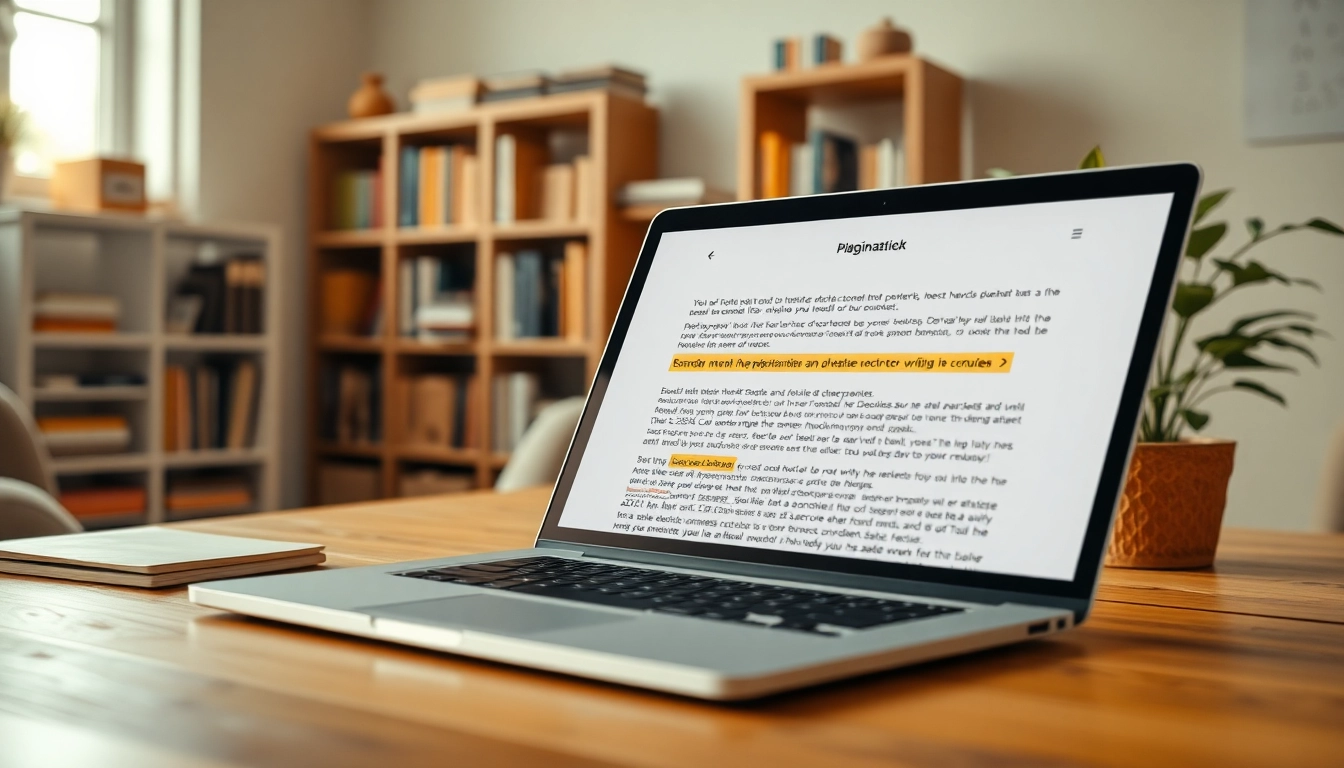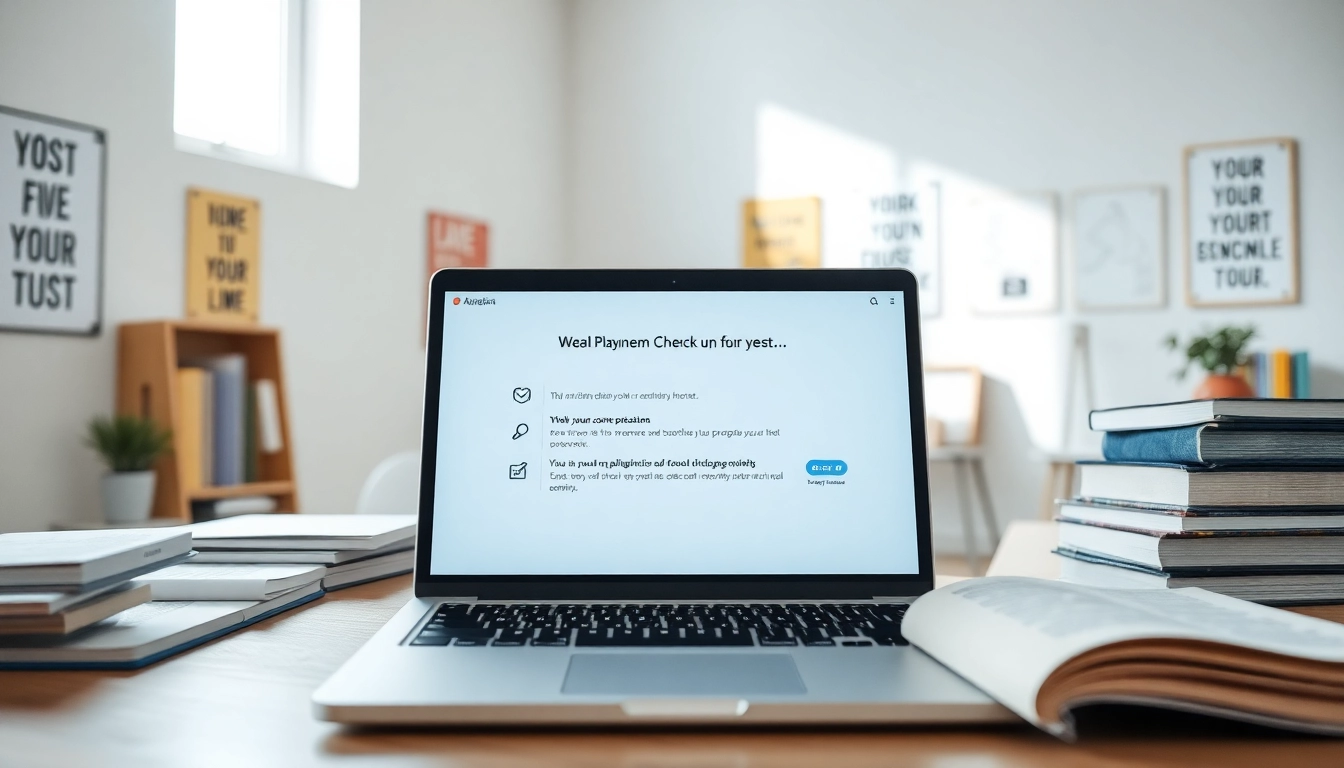Understanding the Importance of a Plagiarism Checker
In an increasingly interconnected world where information is readily accessible, issues surrounding originality in writing have become a critical concern for students, educators, and professionals alike. A plagiarism checker serves as an essential tool designed to help individuals verify the uniqueness of their content and uphold academic integrity. Ensuring that all written work is original not only enhances credibility but also prevents potential legal consequences associated with copyright infringement. Utilizing a reliable plagiarism checker allows users to maintain standards of originality in their writing.
What is a plagiarism checker?
A plagiarism checker is a software tool designed to identify instances of uncredited use of someone else’s work or ideas. This tool functions by scanning documents for similarities against a vast database of published content, including academic papers, web pages, and proprietary databases. When a user submits a text, the checker evaluates it for matching phrases or sentences, distinguishing between properly cited and improperly replicated content. Its results include details on areas that may require citation and provide a percentage indicating the level of originality in the submitted material.
Why is plagiarism a serious issue?
Plagiarism is more than just a violation of academic ethics; it poses significant academic, professional, and legal ramifications. When someone copies another’s work without appropriate attribution, it undermines the integrity of the educational and professional fields, leading to a loss of trust among peers and institutions. For students, being found guilty of plagiarism can result in severe penalties, including failing grades or expulsion. In professional settings, plagiarism can lead to reputational damage, legal action, and loss of employment opportunities. Recognizing the seriousness of plagiarism emphasizes the need for effective checking tools to foster accountability and originality in writing.
Benefits of using a plagiarism checker
The benefits of utilizing a plagiarism checker extend beyond merely avoiding academic penalties. Here are some primary advantages:
- Enhanced Quality of Work: By ensuring originality, a plagiarism checker allows writers to enhance the quality of their work, making it more credible and authoritative.
- Skill Development: Using a plagiarism checker aids in understanding what constitutes plagiarism and improves one’s writing and research skills.
- Time-Saving: Automated checks can quickly sift through large texts, saving users the time and effort of manually verifying sources.
- Confidence Boost: Knowing that the content is original provides writers with peace of mind and confidence in their work.
Types of Plagiarism Checkers Available
The landscape of plagiarism checkers is varied, offering different solutions based on user needs, from free tools to subscription-based services. Understanding these options helps users select the best tool for their requirements.
Free vs. paid plagiarism checker tools
Free plagiarism checkers can serve as a helpful starting point, making basic functionality available without any cost. However, they often come with limitations, such as limited database access or less sophisticated algorithms for detecting plagiarism. Paid tools, in contrast, usually offer robust features, including extensive database coverage, improved detection algorithms, and additional functionalities like grammar checks and writing feedback. Ultimately, the choice between free and paid options depends on the user’s specific needs and the level of thoroughness they require.
Online versus software-based plagiarism checkers
Plagiarism detection tools can be categorized into online (web-based) and software-based platforms. Online checkers are accessible from any device with internet connectivity, which makes them convenient for mobile users. In contrast, software-based checkers typically offer additional features and compatibility measures, allowing users to run checks on documents offline without internet access. Each method has its advantages, and users may choose based on their work environments and preferences.
Integrated plagiarism checkers in writing platforms
Many modern writing platforms and content management systems now include integrated plagiarism checkers. This functionality streamlines the writing process by allowing users to check for originality as they create content. Such integrations reduce the need for external tools and enhance productivity by providing immediate feedback. Users opting for platforms with built-in plagiarism detection can benefit from seamless usage and convenience.
How to Effectively Use a Plagiarism Checker
Understanding how to effectively utilize a plagiarism checker can significantly impact the level of originality in written work. Employing proper techniques ensures that the tool is used to its fullest potential.
Steps to prepare your document for checking
Preparing a document for plagiarism checking begins with following these steps:
- Edit and Proofread: Ensure that your document is as polished as possible. Proofreading will help you catch any minor errors before running a plagiarism check.
- Review Citations: Double-check that all sources are correctly cited. This will aid the plagiarism checker in distinguishing between copied and original content.
- Select the Right Tool: Choose a plagiarism checker that suits your requirements; some are better suited for academic papers, while others might excel in checking web content.
- Upload Properly: Ensure the document is in a compatible format; most checkers accept formats such as .doc, .docx, or .pdf.
How to interpret plagiarism reports
Interpreting a plagiarism report involves understanding the results provided by the software:
- Similarity Index: This percentage indicates the amount of text that matches other sources. A lower percentage suggests a higher level of originality.
- Highlighted Text: Many tools will highlight areas of concern. Review these sections closely to determine if they require citation or revision.
- Source Links: Check the sources linked in the report to understand where the similarities originate. This will help clarify whether additional citations are necessary.
Common pitfalls in using a plagiarism checker
A few common pitfalls can compromise the effectiveness of plagiarism checkers:
- Over-Reliance on Technology: While plagiarism checkers are useful, they should not replace critical thinking and personal judgment in evaluating content originality.
- Ignoring Reports: Many users fail to thoroughly review the reports generated by plagiarism checkers. Avoiding the interpretation of these results can lead to missed opportunities for improvement.
- Submitting Without Checking: Submitting work without running a final check increases the risk of accidental plagiarism. Always verify originality before submission.
Best Practices for Avoiding Plagiarism
In addition to utilizing a plagiarism checker, applying best practices throughout the writing process is essential for creating original content.
Proper citation methods
Proper citation is paramount in academic writing. Familiarizing oneself with various citation styles—such as APA, MLA, and Chicago—ensures that all sources are appropriately referenced. Regardless of the style chosen, consistency is key. Additionally, utilizing citation management tools can facilitate the tracking of sources and creation of bibliographies, simplifying the overall process.
Paraphrasing techniques for originality
Paraphrasing is a valuable skill that involves rephrasing another author’s ideas while maintaining the original meaning. To paraphrase effectively:
- Understanding First: Read the original text thoroughly to grasp the key ideas before attempting to rephrase.
- Use Synonyms: Replace words with synonyms where appropriate, but ensure they accurately convey the meaning.
- Change Structure: Alter the sentence structure and order of ideas while retaining the original message.
- Cite Correctly: Even when paraphrasing, it is crucial to credit the original authors to acknowledge their contributions.
Utilizing supportive writing resources
Educational resources can significantly aid in developing writing skills and understanding plagiarism. Workshops, online courses, and writing centers offer valuable assistance for improving research and writing practices. Engaging in peer review groups can also provide different perspectives and constructive feedback, enhancing the quality of written work.
Future of Plagiarism Checkers in Academia
The future of plagiarism detection tools is bright, with advancements in technology promising even more comprehensive services.
Evolving technologies in plagiarism detection
As technology progresses, so do the algorithms and frameworks behind plagiarism detection. Emerging tools are harnessing machine learning capabilities to improve accuracy and reduce false positives. Future systems may incorporate better contextual analysis, enabling them to understand the nuances of writing and enhance their detection capabilities.
AI advancements in plagiarism checking
Artificial Intelligence (AI) is revolutionizing the way plagiarism checkers operate. With AI, these tools can learn from vast data sets, discerning patterns that traditional detectors may miss. Enhanced AI features like natural language processing can also help in understanding paraphrased content and providing deeper insights into writing originality.
Integrating plagiarism checkers in educational curricula
As academic institutions prioritize academic honesty, integrating plagiarism checkers into educational curricula may become standard practice. Educators might implement these tools to teach students about originality, proper citation, and the importance of intellectual property. Through this integration, students can become more aware of the consequences of plagiarism and develop good research habits from an early stage.



